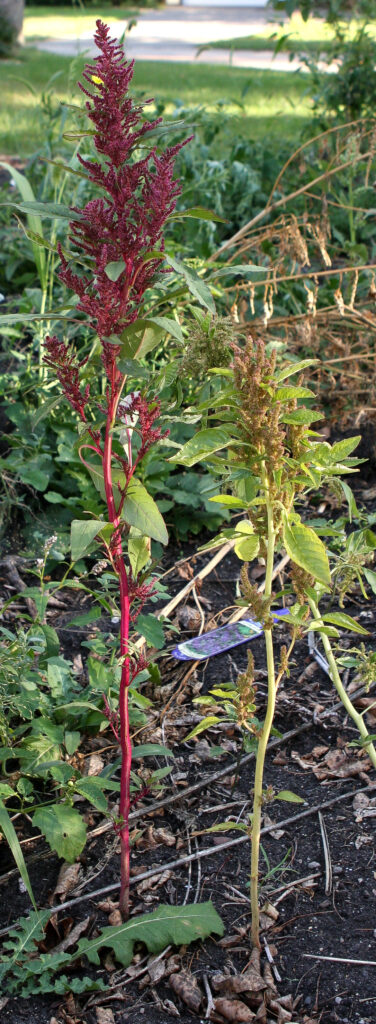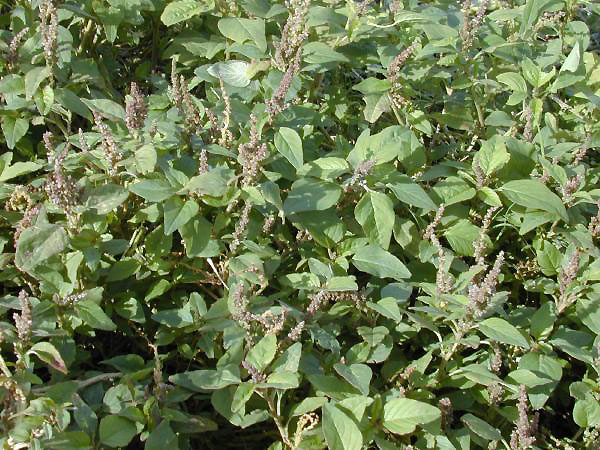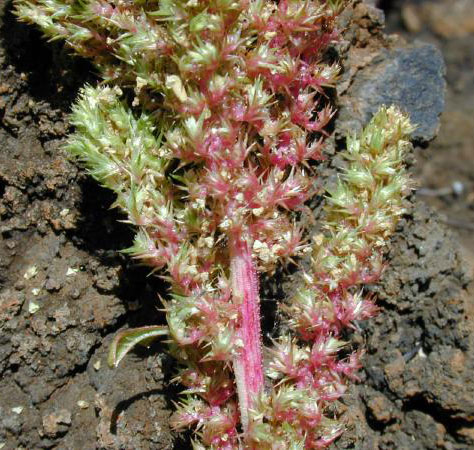Where to Grow Amaranth
Amaranth is a summer-tolerant green that is often called vegetable amaranth to distinguish it from the similarly named but different landscaping amaranth. In the Caribbean, it goes by the name calaloo. The smaller varieties planted as decoration will not produce any usable seed but can still be eaten as salad greens. Unlike most salad greens, this one thrives in hot weather, so if you grow amaranth – or tetragonia, Malabar spinach, orach, or purslane for that matter- you can keep the salads coming all year long. Amaranth delivers salad greens when lettuce and spinach have long since bolted. In addition to tasting somewhat spinach-like, amaranth is healthful: Lots of protein, vitamins, minerals, and dietary fiber. In addition to growing for salad greens, it is (maybe more common historically) grown for its grain. Amaranth is a grain very similar to quinoa or couscous. It is very healthy for you and often found in health food stores.
Recommended Varieties of Amaranth
- Red-leaf vegetable amaranth: medium green leaves with burgundy-red overlay creates an attractive splash of color to your summertime salads.
- Black seeded Amaranth varieties tend to remain quite gritty when cooked and are best suited for their greens.
- The golden or lighter colored seeds tend to cook better, and all of them have delectable greens.
- Tampala is one of the tastiest varieties grown for its greens.
Soil for Amaranth
Amaranth grows well in a variety of soil types. Generally speaking, those soils suitable for growing lettuce would make a nice place for growing amaranth. Your soil should be finely prepared to achieve the proper seed planting depth. Seeds should be planted no more than 1/4 inch deep.
Planting Amaranth
When –
Direct sow seeds once the soil temperature has reached around 70 degrees F. One gram of seed will sow 50 ft of row, and an acre requires about one pound of seed.
| Temperature | |
| Germination | 70 - 75 F |
| Days to Germination | 8 - 10 days |
| For Growth | >70F |
| Soil and Water | |
| Fertilizer | Moderate feeder, use compost |
| pH | 6.0 - 7.0 |
| Water | Moderate |
| Measurements | |
| Planting Depth | 1/8 - 1/4" |
| Root Depth | 18-36", taproot to 5' |
| Height | up to 4 - 8' |
| Width | 6 - 12" |
| Space between plants | |
| Space between plants | 6 - 18" |
| Space between rows | 12 - 18" |
| Average plants per person | 10 - 12 |
| Harvest | |
| Pick individual leaves as needed. Harvest grain when it readily falls from the seed-head, or after the first hard frost. | |
| First Seed Starting Date: (for transfer to garden) | 48-56 Days before first frost date |
| First Seed Starting Date: (for direct sow) | 14-21 Days after first frost date |
| Last Seed Starting Date: | 90-110 Days before last frost date |
| Companions | |
| Companions | Corn, Onions, Potatoes |
| Incompatibles | Nothing conclusive |
| Seed Longevity | Several years |
How –
Seed should be sown thinly (12 to 15 seeds per foot) in rows 12-18 inches apart. This will encourage thickly developed plants—closer spacing results in smaller heads, which may be preferable for small families. Because the seed is so small, it can be mixed with sand to avoid excessive thinning once the seed has germinated. It is not recommended to broadcast seed because there will not be sufficient spacing for the plants to develop quality grains.
Amaranth seedlings can easily be blocked from emergence by a thin crust on the soil formed after a rain. Selecting soils that are lower in clay and managing the seedbed to minimize the chance of crusting can help ensure a good harvest.
How Amaranth Grows
Amaranth is very easy to grow. It is fairly maintenance-free, but its slow initial growth leaves it susceptible to competition among weeds until it is established. Amaranth prefers a warm climate, full sun, and well-drained soil. It will grow tall and can top 5 feet high. Flowers are produced on long straight stems, are long-lasting, and will bloom from mid-summer until the first hard frost.
Cultivating Amaranth
Amaranth resembles lamb’s quarters and a red rooted pigweed (especially in the early stages of growth), so it is best to plant in rows to simplify weeding. Growing amaranth varieties that have purple or red leaves also simplifies weeding. Amaranth appears to be fairly slow-growing at first, but it can be very drought tolerant once established. It can successfully be grown in areas with less than 10 inches of yearly rainfall. Once the plants reach about one foot in height, they start growing rapidly and quickly shade out any remaining weeds. Amaranth is a fairly low maintenance crop, but care should be taken early to ensure they stand a good chance of establishing. Removing the amaranth plant’s terminal buds will help encourage branching and develop a larger percentage of tender young shoots for salad greens.
| Storage Requirements | ||
|---|---|---|
| Amaranth does not store well for long periods and is best eaten fresh. | ||
| Fresh | ||
| Temperature | Humidity | Storage Life |
| 32 - 40F | 80-90% | 1 month |
| 32F | 98-100% | 2-3 weeks |
Harvesting Amaranth
Pick individual leaves as needed for greens. Younger greens are great for salad; older greens are better cooked as a substitute for spinach. Seed will often ripen many weeks before the first hard frost, usually after about three months from planting time. The best way to determine if the seed can be harvested is to gently but briskly shake or rub the flower heads between your hands to see if the seeds fall readily. Numerous small and appreciative birds may give hints as to when to start doing this. The best time to harvest the amaranth grain is on a dry day 3 to 7 days after a hard frost.
An easy way to gather the grain is to bend the plants over a bucket and rub the seedheads between your hands. This method may take a little longer to do, but there won’t be as much chaff and debris to sort out later. Only the dehydrated seeds will come out this way, so do a second harvest a week or so later to catch any remaining seeds that were not ready the first time. We like to rub the flower heads onto a screen set on a wheelbarrow. The finer chaff can then be blown off the screen. In our experience, cutting and hanging plants indoors does not work very well. The plants become extremely bristly, and it becomes difficult to separate the seed from the chaff.
After harvesting, it is important to dry your crop further to ensure it won’t grow mold in storage. It can be left on trays in the hot sun or placed near an indoor heat source. Stir occasionally until it is as dry as possible—store seeds in an air-tight container in a cool, dry place. Amaranth grain is fairly high in fat and can go rancid eventually. The best way to store it is in the fridge, in a tightly sealed container. The grain should last up to 6 months this way.
Amaranth Pests
- Tarnished plant bug – congregate around the growing seed heads, and by sucking the fluid out, they can stunt the seed production.
- Amaranth weevil- The weevils are a 2-stage threat with the larvae chewing on the roots and the adults going after the leaves.
Amaranth Diseases
Disease is seldom a problem with Amaranth.



